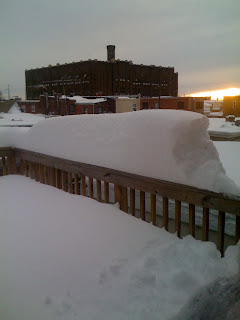But it did get me thinking about alternate cooking methods. I've never been a big fan of microwaves, although I know most people swear by them. Yes, they're good for defrosting leftovers, but anything you can do with a microwave you can do on the stove, and probably better (cf. popcorn, baked potatoes). Without use of the stove, though, I was wondering whether I could discover any recipes that might serve to make me a bit less ambivalent about the microwave.
And I did: microwave chocolate cake. (See also here and here, but the recipe I used is the most chocolaty, natch.)
I admit, I was skeptical. Really, really skeptical. But, my friends, I have made the cake and I have seen the light. The light of chocolate cake.
The ingredients:
The recipe recommends using an extra large coffee mug, which I didn't have, so I worked with my tall cappuccino mug. (See the "D" on the side? That means that whatever is in there is MINE, and you can't have any.)
As recommended, I sifted the dry ingredients together and added them to the mug. I've never bothered much with sifting flour, but it's definitely a necessity for the cocoa powder, which clumps like crazy.
The recipe calls for melting chocolate chips with butter. I didn't have any chocolate chips on hand, but what I did have was leftover chocolate fondue from a dinner party a few weeks ago (thanks, Liz!). Since this already had some oil in it (as well as some bourbon, a nice addition), I used only 2 tablespoons of butter instead of the 3 that the recipe calls for.
I popped this in the microwave to melt it, then added the egg and the soy milk after it had cooled a bit, so as not to scramble the egg.
This whole mess of wet ingredients is supposed to be poured right into the mug to be combined with the dry ingredients already in there. I knew this was a bad idea at the time, and I was right. Although I admire the sentiment to use as few bowls as possible, I couldn't get the batter entirely mixed at the bottom of the mug, and ended up with some unincorporated flour stuck to the bottom of the cake. Guess I should learn to trust my instincts.
The finished batter was about the consistency of a very thick pancake batter and filled the mug most of the way to the top.
It cooked on high for 3 minutes, and started to rise out of the top of the mug about halfway through:
But it held together well enough not to spill over the sides, almost like a soufflé, which is surely its culinary ancestor.
It came out of the microwave bubbling hot on top, so I let it set in the mug for a few minutes before extracting it onto a plate.
As you can see, it broke in half while I was trying to wiggle it out of the mug, and the bottom half is showing my poor mixing skills. But the top half was fantastic: rich, moist, and intensely chocolaty. Bonus: When I first started eating it, it was still warm and gooey inside. Yum.
So I will definitely try this again, modifying the mixing method and cooking vessel accordingly. I could probably even make a few of these cakes at once and pass them off as a serious dessert at the next dinner party. Hmmmm...


















